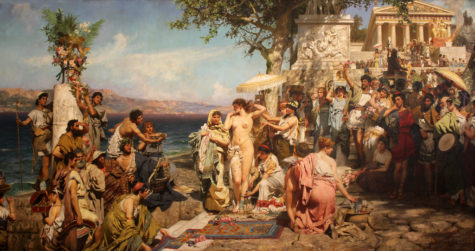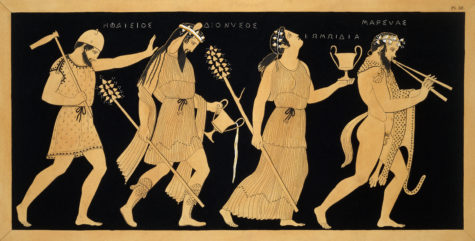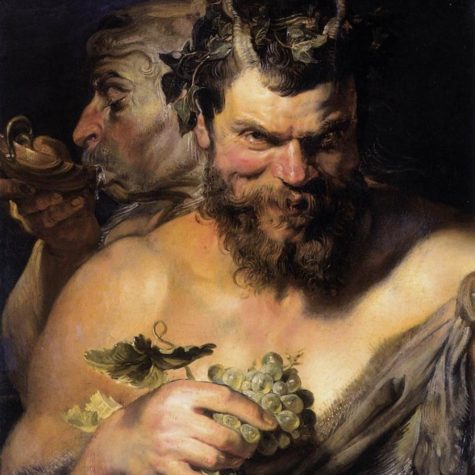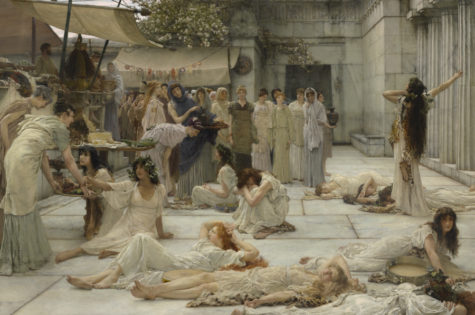Greek Festivals
In ancient Greece, on the 16th and 17th of January, there was held a festival in which offerings were made to the Wind Gods of the eight directions.
Black lambs were offered as sacrifices to the destructive winds, and white ones to favourable or good winds. Boreas (North Wind) had a temple on the river Ilissus in Attica, and between Titane and Sicyon there was an altar of the winds, upon which a priest offered a sacrifice to the winds once in every year. Zephyrus (West Wind) had an altar on the sacred road to Eleusis.
If you are not big on animal sacrifices, you might consider the following:
- Singing or playing The Winds Four Quarters
- Doing a Ritual to the North Wind (since it is January)
- Learn how to use the four winds in magick.
- Practice some windy magick
Alternatively, you might go outside and stand in a high place and offer a pinch of herbs or spice to each of the four winds. Something sweet to sweeten whatever might come your way, might be appropriate.
More about these Windy Gods can be found at The Powers That Be
Poseidon was once worshiped in every part of Greece as a God of general importance to the community. In ancient Greece, the feast day in his honor was widely celebrated at the beginning of the winter.
POSEIDO′NIA (ποσειδώνια), a festival held every year in Aegina in honour of Poseidon. It seems to have been celebrated by all the inhabitants of the island, as Athenaeus calls it a panegyris, and mentions that during one celebration Phryne, the celebrated hetaera, walked naked into the sea in the presence of the assembled Greeks. This was possibly because in Greek mythology, the sea god Poseidon is one of the most lascivious of the gods, producing more offspring than other note worthily randy gods.
Greek calendars vary from place to place, but in Athens and other parts of ancient Greece, there is a month that corresponds to roughly December/January that is named Poseideon for the sea-god Poseidon. The month of Poseidonia’s most anticipated and most important festival is the feast of the Poseidonia, a winter festival in honor of Poseidon. Since Poseidon is a sea god it is curious that his festival would be held during the time the Greeks were least likely to set sail.
It was celebrated with the pouring and drinking of wine, merriment, bonfires, and most likely a form of gift giving. Not much more is known about the way it was celebrated.
On a larger scale, “there was a festival once every fifth year at Sunium in honor of Poseidon – evidently, then, a major event. Also, animal offerings to Poseidon were a common feature at the feast days of other gods, including the “festival at the temple of Hera on the 27th of Gamelion,” which honored the goddess “together with Zeus the Accomplisher, Kourotrophos and Poseidon.”
Related Festivals:
- Haloea – Jan 8 thru 9th
- Poseidonia of Aegina – A Midwinter Festival lasting as long as 2 months
Collected from various sources
The Dionysia was originally a rural festival in Eleutherae, Attica, probably celebrating the cultivation of vines. It was probably a very ancient festival, perhaps not originally associated with Dionysus. This “rural Dionysia” was held during the winter, in the month of Poseideon (the month straddling the winter solstice, Dec – Jan).
The central event was the procession (pompe), in which a symbol of the phallos, sign of fertility, was carried through the dancing and singing procession. Young girls carried baskets, others carried long loaves of bread and other offerings, also carried in the procession were jars of water and wine. The pompe ended with a sacrifice consisting of baked bread or a gruel of cereal.
After the pompe procession was completed, there were contests of dancing and singing, and choruses (led by a choregos) would perform dithyrambs. Some festivals may have included dramatic performances, possibly of the tragedies and comedies that had been produced at the City Dionysia the previous year. This was more common in the larger towns, such as Piraeus and Eleusis. Generally, it was a joyful festival, shared by all, even the slaves.
Because the various towns in Attica held their festivals on different days, it was possible for spectators to visit more than one festival per season. It was also an opportunity for Athenian citizens to travel outside the city if they did not have the opportunity to do so during the rest of the year. This also allowed travelling companies of actors to perform in more than one town during the period of the festival.
The City Dionysia. also known as the Great Dionysia, was the urban part of the festival, possibly established in the 6th century BC. This festival was held probably from the 10th to the 16th of the month Elaphebolion (the lunar month straddling the vernal equinox, Mar – Apr in the solar calendar), three months after the rural Dionysia, probably to celebrate the end of winter and the harvesting of the year’s crops.
Ways to celebrate in modern times:
Sing, dance, play games, attend or participate in a parade or comedic theater of some sorts. Create phallic-shaped cakes for consumption and sacrifice. Read The Archanians by Aristophanies, which provides a glimpse of the festival. Display images and symbols of the God. Recite Orphic Hymns, Homeric Hymns, (all to Dionysos), or even hymns of your own creation.
I celebrate the Rural Dionysia following immediately the Heliogenna lasting through January 1. I pack baskets with gifts of nuts, wine, silly games and gifts, and DVD’s of comedies. Then I deliver those baskets, not more than one a day or evening, to friends and family. I spend the evening with the basket recipient and we eat the snacks, watch the DVDs, and drink the wine.
We also play the silly games and laugh. You don’t have to give the DVDs, you could just bring over a bottle of wine and a DVD from your collection or a netflix. That’s how I celebrate it since that is pretty close (in spirit) to what the Rural Dionysia was all about. – Cara Schulz
The Ancient Hymns
- The Fumigation from Storax.
Bacchus I call, loud-sounding and divine, fanatic God, a two-fold shape is thine: Thy various names and attributes I sing, O, first-born, thrice begotten, Bacchic king: Rural, ineffable, two-form’d, obscure, two-horn’d, with ivy crown’d, euion, pure. Bull-fac’d, and martial, bearer of the vine, endu’d with counsel prudent and divine: Triennial, whom the leaves of vines adorn, of Jove and Proserpine, occultly born. Immortal dæmon, hear my suppliant voice, give me in blameless plenty to rejoice; And listen gracious to my mystic pray’r, surrounded with thy choir of nurses fair.
- A Hymn
Come, blessed Dionysius, various nam’d, bull-fac’d, begot from Thunder, Bacchus fam’d. Bassarian God, of universal might, whom swords, and blood, and sacred rage delight: In heav’n rejoicing, mad, loud-sounding God, furious inspirer, bearer of the rod: By Gods rever’d, who dwell’st with human kind, propitious come, with much-rejoicing mind.
- The Fumigation from Manna.
Liknitan Bacchus, bearer of the vine, thee I invoke to bless these rites divine: Florid and gay, of nymphs the blossom bright, and of fair Venus, Goddess of delight, ‘Tis thine mad footsteps with mad nymphs to beat, dancing thro’ groves with lightly leaping feet: From Jove’s high counsels nurst by Proserpine, and born the dread of all the pow’rs divine: Come, blessed pow’r, regard thy suppliant’s voice, propitious come, and in these rites rejoice.
- The Fumigation from Aromatics.
Bacchus Pericionius, hear my pray’r, who mad’st the house of Cadmus once thy care, With matchless force, his pillars twining round, (when burning thunders shook the solid ground, In flaming, founding torrents borne along), propt by thy grasp indissolubly strong. Come mighty Bacchus to these rites inclin’d, and bless thy suppliants with rejoicing mind.
- To Dionysus
Of ivy-tressed uproarious Dionysus I begin to sing, the splendid son of Zeus and renowned Semele. Him did the fair-tressed nymphs foster, receiving him from the king and father in their bosoms, and needfully they nurtured him in the glens of Nysê. By his father’s will he waxed strong in the fragrant cavern, being numbered among the Immortals. Anon when the Goddesses had bred him up to be the god of many a hymn, then went he wandering in the woodland glades, draped with ivy and laurel, and the nymphs followed with him where he led, and loud rang the wild woodland. Hail to thee, then, Dionysus of the clustered vine, and grant to us to come gladly again to the season of vintaging, yea, and afterwards for many a year to come.
Sources: Wikipedia, Hellenionstemenos, and Project Gutenberg
 In Greek tradition, the Goddess Mnemosyne gave birth to the Muses today (June 14) – the nine creative spirit children that give our lives so much beauty, song, stories, tradition, humor, dance, and sacred music. For a magickal celebration here is something from A Daily Guide to the Magic and Inspiration of the Goddess.
In Greek tradition, the Goddess Mnemosyne gave birth to the Muses today (June 14) – the nine creative spirit children that give our lives so much beauty, song, stories, tradition, humor, dance, and sacred music. For a magickal celebration here is something from A Daily Guide to the Magic and Inspiration of the Goddess.
- Themes: Creativity; Knowledge; History; Art
- Symbols: Fountains; Springs; the Number Nine
- Presiding Goddess: Mnemosyne
About Mnemosyne:
Greeks sometimes worshiped Mnemosyne in the form of a spring, alluding to her profuse, flowing energy. Mnemosyne means “memory.” Remembrance is this goddess’s gift to us, memories of all the wonderful moments of our lives.
To do today:
Absolutely anything thoughtful, creative, or inspiring will grab Mnemosyne’s attention and encourage her participation in your day. Try donning a unique combination of clothing that really motivates you to do your best, or something that provokes fond memories from the past. Wear an aroma that arouses your inventive nature or cognitive abilities (jasmine and rosemary are two good choices, respectively).
If there are special arts that you’ve learned from family or friends, celebrate them today. Hum that little ditty from your childhood, dust off that neglected craft item, try those recipes, listen to old songs, and let Mnemosyne fill your hours with the encouragement that comes from fond “musings.”
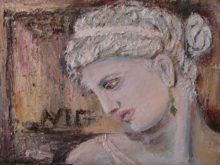 Themes: Cleansing; Mercy; Fertility; Luck; Protection: Providence: Kindness
Themes: Cleansing; Mercy; Fertility; Luck; Protection: Providence: Kindness
Symbols: Leeks; Onions; Grain; Honey Cake
Presiding Goddess: Charila
About Charila: Charila comes to our aid when there is a famine, a drought, or some kind of abuse, be it in the earth or in our spirits. Greek mythology tells us that Charila was a young girl who approached a king seeking food. The king was angered and slapped her. Charila hung herself in disgrace, but not without some notice by the Delphic oracle. The prophetess told the king to change his unsympathetic ways and make offerings to Charila to appease her spirit. Some traditional offerings for her include honey cakes and grains.
About this holiday (June 3):
On the first day of the Thargelia, a festival of Apollo at Athens, two men, the Pharmakoi, (usually slaves, cripples or criminals), were led out as if to be sacrificed. This practice was also relied on in times of disaster (famine, invasion or plague) or other times of crisis. It was believed that this would bring about purification. During this observance in Greece, the Pharmakoi were ritually driven out of the city with leeks and onions rather than being executed. This act of mercy propitiated Charila, cleansed the city of its “sins,” and ensured continuing good fortune for the region. This also brought fertility, onions being an aphrodisiac.
To do today (or whenever a purification is needed):
To draw Charila’s kindness or good fortune to your home, take a handful of any type of grain and sprinkle it on the walkway near your living space saying:
Follow me, wherever I roam,
and let tenderness and luck fill my home!
And whenever you need Charila’s mercy, productivity, forgiveness, or protection, definitely add onions and leeks to the menu. Alternatively, you could make 2 poppets or dolls to represent your situation, and toss them off your property along with a handful of leeks or baby onions.
From: 365 Goddess and other sources
At dusk on January 8th, the Haloa (῾Αλῶα) starts. Haloa took place every year, during the month Poseideon (Ποσειδέωνας), after the first harvest was over. The festival took place around the threshing floor (αλώνια) at the same time throughout Attica. At Eleusis there was a festival called Haloea on the 26th of the month Poseideon.
All women were expected to attend this event, but men were almost always excluded. Interestingly enough, men had a legal and moral expectation to pay for their wives’ expenses in these festivities. The strange timing of the harvest festival—mid-winter—is significant as well.
The Haloea, a festival for Demeter and Dionysus, included a procession for Poseidon. The Haloea is thought to have been a time for merriment. There is mention of a women’s rite in connection with this holiday: Women are provided with wine and food, including cakes in the shapes of sexual organs. They withdraw to themselves and “exchange scurrilous banter, and are teased with suggestions of promiscuity whispered in their ears by ‘the priestesses’.” The women are thought to have stayed secluded throughout the night and then to have joined the men the next day. While the women were off eating, drinking, and sounding much like the women of Lysistrata, the men are thought to have created a big pyre or a bunch of little bonfires.
The Greeks regarded the festival as sacred to not only Demeter but also to Dionysus. With the inclusion of Dionysus in the festival worship, the date shifted towards the winter as “he possessed himself of the festivals of Demeter, took over her threshing-floor and compelled the anomaly of a winter threshing festival.” In many ways, the festival was just as connected, if not more so, with Dionysus than with Demeter. Thus, we see the power and influence of the incoming god and of the importance of wine to Greek cult activity. Practically, Greeks were able to coax out a harvest just early enough to revel with Dionysus.
Despite being among the most documented of Greek festivals, very few records of what exactly occurred during Haloa. Because it was a predominantly, if not exclusively, women’s festival, little information has survived, or was recorded at all, about its characteristics and rituals. In fact, one of the most detailed sources of Haloa actually consists of marginal notes from the 13th century AD on the Roman writer Lucian’s works.
According to these notes, the women’s ritual practices involved “pits, snakes, pigs, and models of genitalia, all of which have a more or less marked sexual significance.” We also know that the festival “is said to have comprised Mysteries of Demeter, Kore, and Dionysus.” Another source singled out these women’s festivals as “containing the germ of ‘Mysteries,’” referencing here the Eleusinian Mysteries—annual initiation ceremonies devoted to the cult of Demeter and Persephone.
Celebrating Haloa
In the earliest times the religious part of the festival might have been restricted to married women, but after the fourth century BCE its celebration may have been limited to hetairai (ἑταῖραι, female companions, a term used non-sexually for women, about women, but used by men to indicate a woman hired for entertainment, often leading to sex), or they were simply also allowed to hold their own symposium during the Haloa, either at home or at Eleusis. The Haloa would have been the day on which they were initiated into the Mysteries. The Eleusinian Arkhontes (Ἄρχοντες, male magistrates of the Mysteries) prepared a huge banquet on this day, with a huge variety, including phallus- and vagina-shaped cakes, but not foods forbidden in the Mysteries: pomegranates, apples, eggs, fowls, some types of fish were out. Animal sacrifice was also disallowed on this day: Demeter received offerings of fresh fruit.
After preparing the food, the Arkhontes left, leaving the women to eat, to drink lots and lots of wine, and to celebrate being a woman and fertile (or the wish to be fertile). The Arkhontes went to the men who were waiting outside of Eleusis for their part in the Mysteries, and told them the story of Eleusis, and how the Eleusinians had discovered nourishment for the entire human race. A giant phallus is often assumed to have been set up on the hálōs, and the women would dance around it carrying clay models of phalli and vaginas, but it is more likely the phallus was never there, but depicted on art work about the Haloa to indicate the fertility aspects of the festival and the dances that occurred there. As part of the festivities, the women engaged in sexualized conversation with each other. As part of the sacrifice, the women carried kernoi (κέρνοι, offering dishes) on their heads, containing incense, grains or other offerings, which they tipped onto the giant phallus or, and this is probably far more accurate, onto the altar.
After the feast and sacrifice, the men who had been waiting were admitted to the grounds, and the women were encouraged by each other–including the priestesses–to take secret lovers for the night. A priest and priestess–with torches representing Demeter and Persephone–apparently sat watch on chests as they presided over the fertility celebration.
To Do Today:
The Haloa is the perfect time to organize an adult ‘girl’s night’ with your closest female friends. Watch a movie with erotic tones, drink wine together, gorge yourselves on chocolate and gossip about your partners. If you have an agreement about it with your partner, you could find a lover for the night. If not, go home to him or her and spend the night together in your own ‘fertility rite’. If you’re single and have no one to fill your bed… well… a girl can get creative, can’t she?
For the men, the Haloa might have had an extra ritual part as well; honoring Poseidon as an agricultural Theos. There is evidence that the men built a huge bonfire and had their own conversations around it. Afterwards, they joined the women, when possible (and desired). Single men; I’m sure you can be as creative as the single women reading this.
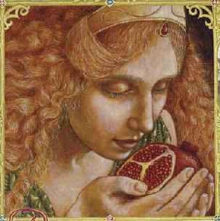 Themes: Luck, Cycles, Youthful Energy
Themes: Luck, Cycles, Youthful Energy
Symbols: Coins, Corn, the number 7, Flower Buds, Pomegranate
About Kore: An aspect of Persephone before her marriage to Hades, this youthful goddess motivates good fortune, zeal, and a closer affinity to earth’s cycles during the coming months.
Kore, whose name means “maiden,” is the youngest aspect of the triple goddess. She was the daughter of Zeus and Demeter, as beautiful as spring’s blossoms and as fragrant as its breezes. It was this beauty that inspired Hades to tempt her with a pomegranate, a symbol of eternal marriage. Because she ate the fruit, Persephone spends winter with Hades as his wife and returns to the earth in spring.
To Do Today (Jan 5 or 6): Traditionally, on this day the Greeks carried an image of Kore around the temple seven times for victory, protection, and good fortune. Since your home is your sacred space, consider walking clockwise around it seven times with any goddess symbol you have (a round stone, vase, or bowl will suffice). As you go, visualize every nook and cranny being filled with the yellow-white light of dawn, neatly chasing away any lingering winter blues.
This day marks winter’s passage and perpetuates Kore’s gusto and luck in your home year-round. Also consider carrying a little unpopped popcorn in your pocket to keep Kore’s zeal and vigor close by for when you need it.
Other Rites of Kore: Epiphanius (fourth century), gives an account of a rite held at Alexandria on the night of January 5-6.
In the temple of Kore – the Maiden (Persephone) – he tells us, worshipers spent the night in singing and flute-playing, and at cockcrow brought up from a subterranean sanctuary a wooden image seated naked on a litter. It had the sign of the cross upon in gold in five places – the forehead, the hands, and the knees. This image was carried seven times round the central hall of the temple with flute-playing, drumming, and hymns. It was said: “To-day, at this hour, hath Kore (the Maiden) borne the Aeon.” The image was then taken back to the underground chamber.
Courtesy of: 365 Goddess and other sources
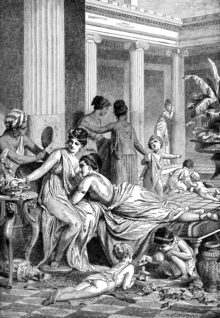 In Athens and other parts of ancient Greece, there is a month that corresponds to roughly December/January that is named Poseideon for the sea-god Poseidon. The Poseidonia of Aegina may have taken place in the same month. Presumably on or around the Winter Solstice.
In Athens and other parts of ancient Greece, there is a month that corresponds to roughly December/January that is named Poseideon for the sea-god Poseidon. The Poseidonia of Aegina may have taken place in the same month. Presumably on or around the Winter Solstice.
There were 16 days of feasting with rites of Aphrodite concluding the festival. Like the Roman festival of Saturnalia, the Poseidonia became so popular it was extended so that Athenaeus makes it 2 months long.
Poseidon as savior of ships, protector of those who voyage in ships, and God of the lapping waters both salt and fresh important for agriculture, is thanked for the many gifts that came from faraway places that were likely given at that time. The immense trade and distribution was nearly all through shipping, relatively little overland, whether it be perfume from Cyprus or pottery from Corinth.
It is interesting today that Agios Nikolaos (Saint Nikolas) is the Patron Saint of seafarers in the Orthodox Church. Celebrating Poseidon’s Festival seems to be lost in modern practice. It likely entailed bonfires, feasting, cutting of trees (probably decorated), and very likely gift giving. As God of begetting, that aspect was not forgotten.
The most complete account of the festival is Noel Robertson’s article Poseidon’s Festival at the Winter Solstice, The Classical Quarterly, New Series, Vol. 34, No. 1. (1984), pp. 1-16:
“The record shows that Poseidon was once worshiped in every part of Greece as a god of general importance to the community.”
“The festival falls near the winter solstice, and the ritual business marked by jollity and license, belongs to the general type of solstice festival known the world over. At Poseidon’s festival, however, the sportive conduct has a definite purpose; this purpose arises from the fundamental agrarian background if Mediterranean society, and may bring us close to the origin of solstice festivals.”
“It has scarcely been noticed that festivals of Poseidon, more than those of any other Greek deity, fall at just this time of year; yet the evidence is extensive.”
“The festival Poseidea and some of the rites in question are often claimed for Poseidon the sea-god, but at this season sailing is furthest from one’s mind, and fishing on the shore is by no means an overriding concern. Such details as we have point elsewhere, to Poseidon as the god of fresh water who fructifies Demeter’s fields.”
One of Poseidon’s epithets is prosklystios, ‘of the lapping water’. He is also invoked as Poseidon phytalmios which implies natural fertility and human procreation. There are also implications in the legends that imply bonfires at the winter solstice.
Noel Robertson concludes:
“…the celebrants feast to satiety, then turn to lascivious teasing. What is the ritual purpose of such conduct? It obviously suits Poseidon’s mythical reputation as the most lustful of gods, who far surpasses Apollo and Zeus in the number of his liaisons and his offspring. Poseidon the seducer is the god of springs and rivers; his women typically succumb while bathing or drawing water; the type of the river god is a rampant bull. But the ritual likewise treats Poseidon as a procreant force; witness the epithets phytalmios, genesios, pater, etc. as interpreted above. The myths and the ritual reflect the same belief. The rushing waters are a proponent male power, just as the fields which they fertilize are a prolific female. Both water and the fields, both Poseidon and Demeter, can be made to operate by sympathetic magic. The rites of our winter festival rouse Poseidon and bring the rushing waters…”
It is interesting that that Theophrastus tells us that the silver fir was important in ship building, especially for masts. The ‘tannenbaum’ is a silver fir. It is also interesting to compare with the Roman Saturnalia which may very well have borrowed from the Poseidea.

